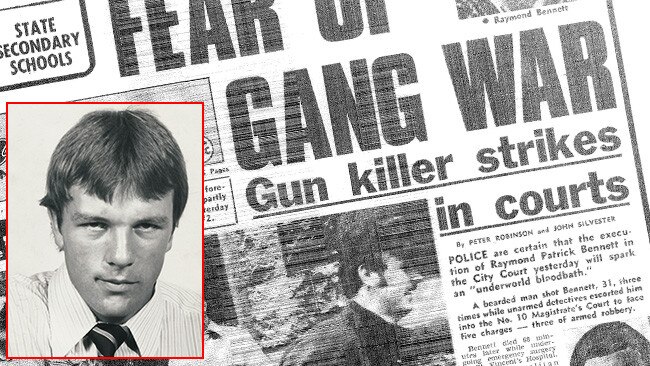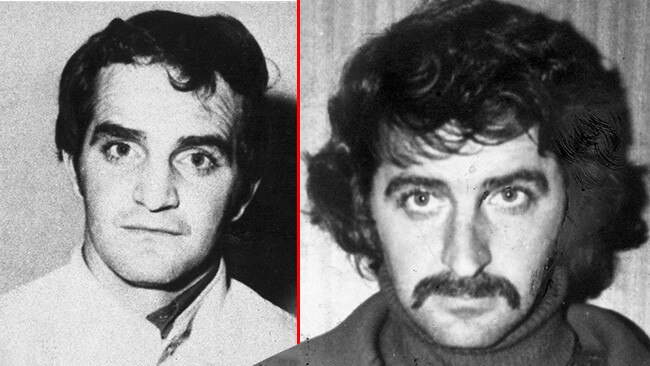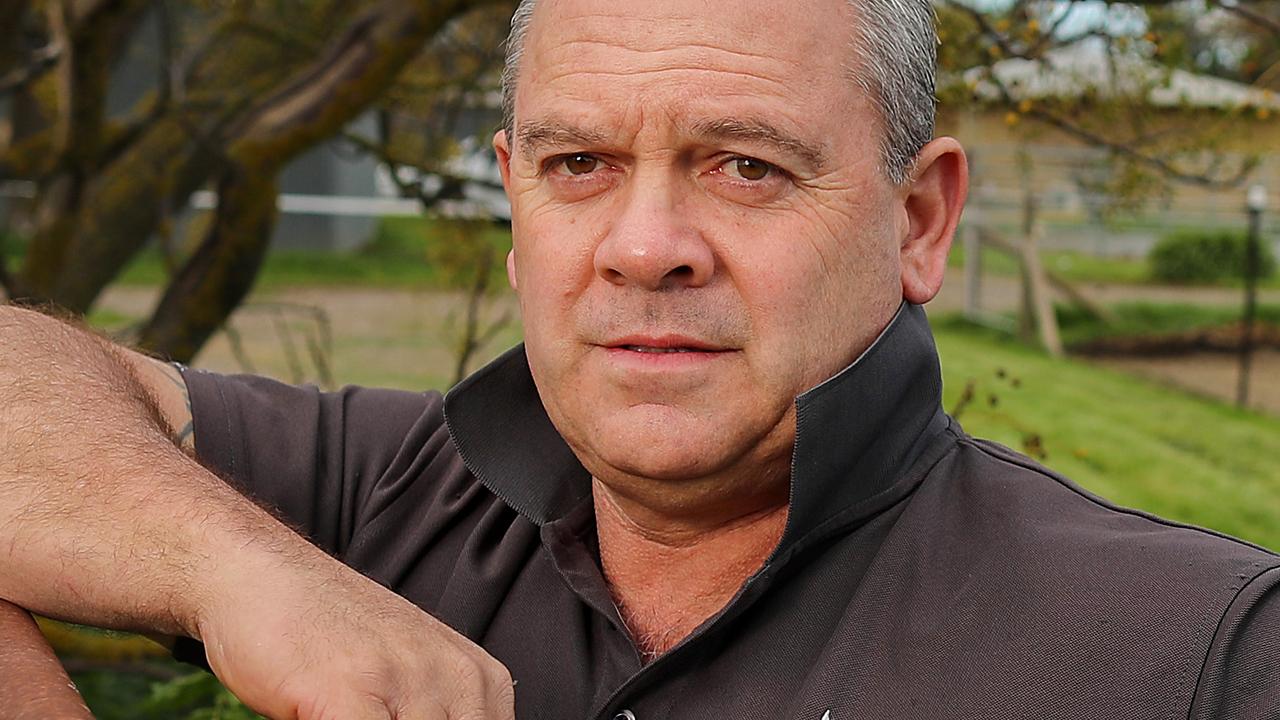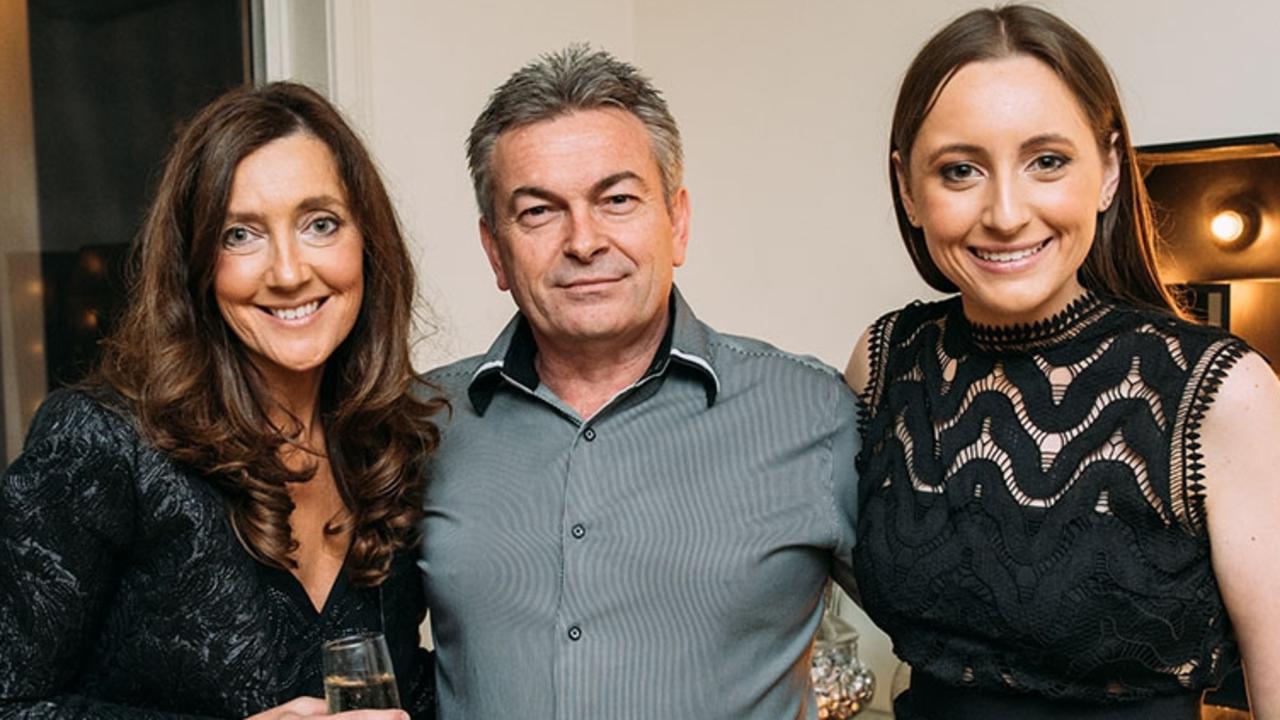Podcast Companion: The day Ray Chuck - AKA Bennett - was gunned down in a Melbourne court
In the tiny lull before the screaming started, Andrew Rule knew the sound was that of gun shots. He’d been following police escorting Bookie robber Chuck Bennett into court when the chaos unfolded around him. NEW PODCAST - LISTEN NOW.

Andrew Rule
Don't miss out on the headlines from Andrew Rule. Followed categories will be added to My News.
Even when he was a kid in Chiltern in northern Victoria, Ray Chuck was on the bad side of tough.
A neighbour once saw him grab an axe and chop down the door of a shed where a terrified boy was trying to hide from him.
By the time young Chuck became known around the Melbourne waterfront and inner suburban pubs, he had a criminal history “docket” (mostly in his alternative name, Raymond Patrick Bennett) that showed he hadn’t changed his ways, just targets and weapon of choice. The country boy had moved up to the criminal big time.
SUBSCRIBE TO LIFE AND CRIMES: iTUNESWEBSPOTIFY
Some liked him, some hated him. But no one ignored the dashing crook credited with masterminding the Great Bookie Robbery in April 1976. He was credited, in fact, with planning the famous heist like a military operation while banged up in a British prison.

This was the man who once walked free from a court by swapping identities with a vagrant charged with drunk and disorderly.
“Chuck was deep and dark,” says the wife of one of his victims. She was one of many widows left by the vicious war between painters and dockers, a war that erupted when a gang of “toe cutters” came looking for the bookie robbers’ stash of cash.
It is 35 years this week since the spring day when Bennett was shot dead at the old Melbourne Magistrates’ Court in one of the most audacious — but officially unsolved — crimes committed in Australia. It was a murder motivated by revenge in what became a crime vendetta.
When they brought him into Court One from the holding cells, he was wearing a loud check sports jacket with leather patches on the elbows, like something Gillon McLachlan might have worn to picnic races. But if the jacket said jackaroo, the face was more desperado, with flattened nose and hard eyes.
Two unarmed consorting squad detectives appeared, apparently to escort Bennett into the courtyard and upstairs to another court. I was about to follow when the unthinkable happened.
In the tiny lull before the screaming started, you knew they were gun shots. The three bangs were too close together to be a car backfiring.
You could hear the slap of running feet and the yelling of terrified people in the courtyard outside. A big cop blocked the door to keep us in and possible invaders out. I scrawled the time in a notebook. It was precisely 10.17am, the Monday after Dulcify died in Hyperno’s Melbourne Cup.
I scrambled to the telephone on the clerk’s desk occupied by Bernie Balmer, in those days clerk of courts and not yet “Bernie the Attorney”, later barrister of choice for choosy crims. The idea was to call a photographer but by the time one came it was too late.

One of the last to see Bennett alive was his robust young lawyer, Joe Gullaci, who would later become a top criminal advocate and a judge.
If Bennett wasn’t dead by the time he got to St Vincent’s, he was by the time they got him on the operating table. A snub-nose .38 pistol at close range will do that. The idea of installing metal detectors at every court must have been born that day.
The gunman, a neat figure in a blue suit, beard and gold-framed glasses, looked like a lawyer. Julie Herd, a court reporter for this newspaper’s predecessor, The Sun, sat next to him outside the upstairs courtroom. She noticed nothing unusual about him. He sat calmly until the time was ripe.
When Bennett appeared with the detectives, the bearded man got up walked over to him, pulled the pistol from inside his jacket and snarled “Cop this, you mother----er!” then shot him three times. The two detectives jumped back but when one moved towards the gunman he menaced them with the pistol and warned, “Don’t make me do it”.
As the fatally wounded Bennett ran downstairs carried by instinct and adrenalin, a detective chased him thinking the gunman had fired blanks as part of an elaborate escape attempt. Bennett collapsed on the landing between two flights of stairs. Two uniformed policemen who ran up from the courtyard saw he had his arms crossed over his chest and was bleeding.
He told them: “I’ve been shot in the heart.’’ They were almost certainly his last words.
Joe Gullaci rushed downstairs with Bennett’s wife, Gail. He pushed her into the clerk’s office so she couldn’t see how badly her husband was wounded. When the ambulance came, police stopped the pair getting in it to go to St Vincent’s. Instead, they jumped in a police car, but the driver took them in exactly the wrong direction — towards Elizabeth St.

That mistake summed up the bungling that day — except for the hit man, whose timing and preparation was almost too good to be true.
He got away smoothly via a prearranged escape route involving unused back stairs and an exit into the magistrates’ garage, where someone had thoughtfully bent up a sheet of corrugated iron, opening a gap into the RMIT car park next door.
A snub-nose .38 pistol.
Bennett’s death was the second act of a true-crime drama featuring three killings as audacious as anything in the gangland war fought by the next generation of criminals.
The first was the murder of Les Kane, a ferocious “dockie” and brother of standover man Brian Kane, a former Golden Gloves boxer who was feared but didn’t have Les’s psychopathic streak.
Les, described by someone close to him as “the most violent man in Australia”, had declared war on Bennett and his mates, Vinnie Mikkelsen and Laurie Prendergast. He had moved his family to a unit in Wantirna to keep them out of harm’s way. It didn’t work. The cunning Bennett mounted a pre-emptive strike.
It happened on a Thursday night in October the previous year, 1978. The Kane family had been out for a meal. When they got home, the family’s tiny dachshund was outside the front door, sitting on a seat. Judi Kane didn’t realise until later that someone must have let the dog out and lifted him on to the seat, as his legs were too short to jump that high.
The intruders were kind to dachshunds but not to dockers. One shoved Judi and the kids into a room and held them down while the other two, armed with fully automatic weapons, trapped

Les Kane in the bathroom and riddled him with bullets. They dragged the body to the door and threw it into the boot of Kane’s pink Ford Futura. Neither the car nor the corpse was ever seen again.
The gunmen wore balaclavas but Judi knew the three she saw. There might have been a fourth hidden in a getaway car outside. She was in total shock but stuck by the code. She called the Kane family to come and help her clean up the blood of her children’s father. The police did not turn up until they heard about it on the criminal grapevine.
When Brian Kane rushed to the scene he was white with anger. He hated the Bennett crew, now he was determined to exterminate them. The vendetta started much earlier, some say, in a Richmond pub brawl, in which Vinnie Mikkelsen had committed the social error of biting off part of Brian Kane’s ear.
As Joe Gullaci would muse years later, it’s hard to be the No. 1 standover man when someone has bitten off the top of your ear. The law of the jungle demanded that the Kanes strike back.
Brian Kane vowed revenge for his brother’s death. It was an open secret that Bennett, Prendergast and Mikkelsen had targets painted on them.
Bennett was happy to be remanded on separate robbery charges because it got him off the street and into jail, where he thought he could protect himself. He even tried to get life insurance that would benefit his wife and young son if he was killed.
The insurance didn’t work and neither did his plan. The lax security at the magistrates’ court gave his enemies the chance they were counting on.
MORE PODCAST COMPANIONS
ON THE LOOSE: AUSTRALIA’S MOST WANTED
Impeccable sources say Brian Kane was the trigger man. There has always been speculation he had inside help from bent police who favoured the Kanes ahead of the Bennett camp.
According to the same source, Kane was driven to the airport by another brother (also a convicted killer) and flew to Perth to “cool off”. But his cards were marked and he knew it. He would have to come back to Melbourne to collect his “dues” from SP bookmakers and illegal card and two-up games. Meanwhile, Bennett’s friends would watch and wait.
Almost exactly three years later, the final act played out: Brian Kane was shot dead in the Quarry Hotel in Brunswick. Kane was with a female friend, and had reputedly hidden his handgun in her handbag in case of being searched. The handbag manoeuvre was a good way to avoid arrest but not so good for avoiding bullets.
When Kane saw two masked men slip into the hotel he knew they weren’t there to rob the till. He died game. He pushed the woman down so she was out of danger and tipped up a table in front of them as a shield. It was no use.
The identity of the gunmen has always led to speculation. But the most consistent theory is that one was Russell “Mad Dog” Cox, master robber and escape artist. With him, some say, was a cold-blooded killer called Rodney Collins, also known as Rodney Earle.
There are a couple of postscripts to the story. Bennett’s mate Laurie Prendergast parked his Volvo one day in 1985 and vanished. His body has never been found. Vinnie Mikkelsen reputedly spent many years in outback Western Australia before finally resurfacing in the eastern states, where he still keeps a low profile.
But one of the most intriguing things is the message that was the last thing Raymond Patrick Chuck (alias Bennett) ever read. It was fresh graffiti written on the magistrates’ court cells by some criminal Nostradamus.
“Ray Chuck, you will get yours in due course. You f---en dog.”



